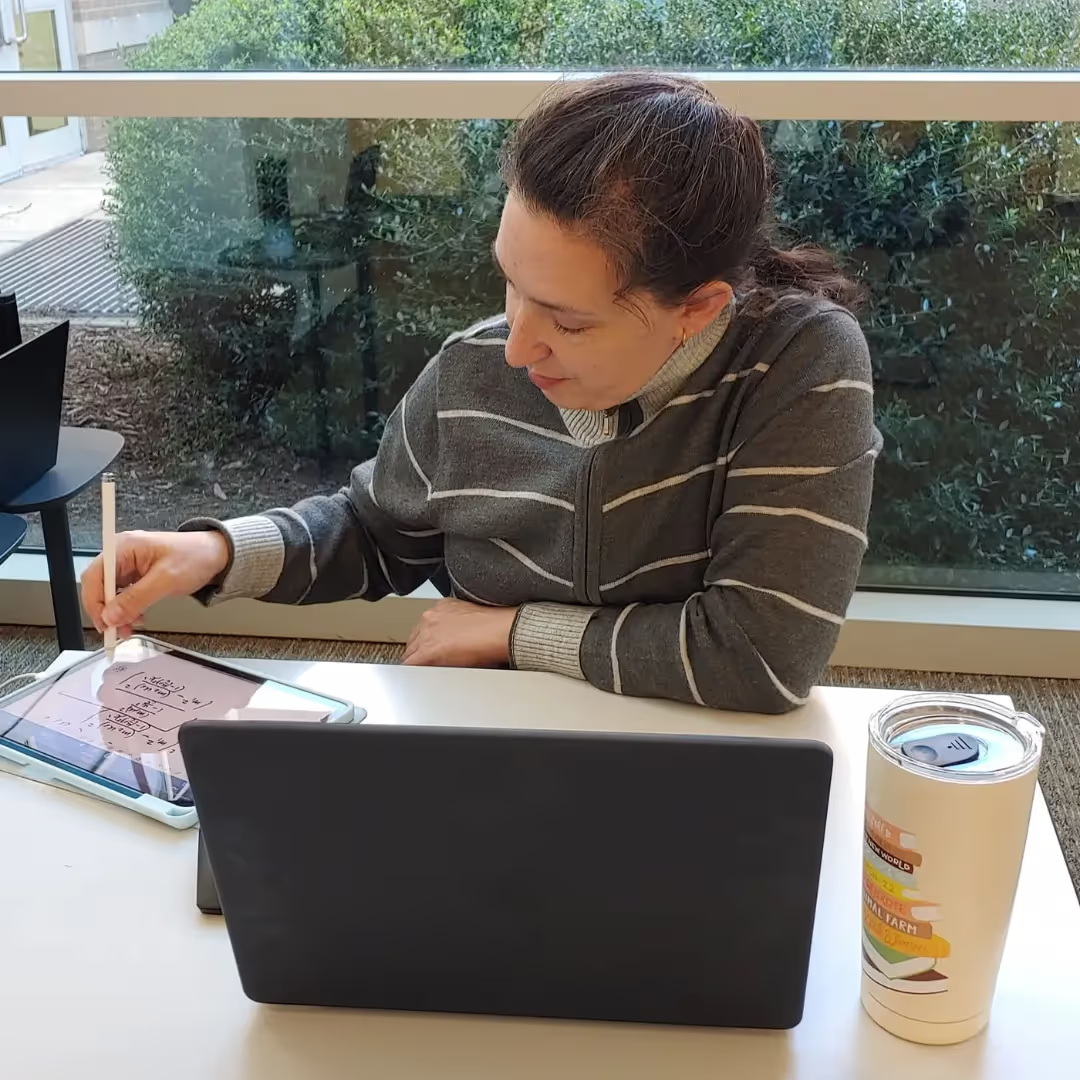
So you’re a teacher thinking of leaving the profession. First of all, we’ll just say: you’re not the only one. Especially because of the pandemic and plateauing salaries, many other teachers are also looking into a career change — and preferably, they want jobs outside of teaching altogether.
In fact, this is the background many of our students are coming from. And it’s led us to a clear conclusion: The best careers for former teachers are in tech.
Here’s why.
Why former teachers should consider jobs in tech: Higher salaries
We’ll just come out and say it: tech has numerous jobs for ex-teachers that pay well. As of this writing, the average salary for a public school teacher was $53,551 — and that’s taking into account all levels of seniority and all different specializations.
That needs some more context, though. The vast majority of our students come to us for a complete career change. That means that when they graduate, they need to make their way in a new industry, and thus they take entry-level jobs.
So that nearly $20K salary increase should be interpreted not as an end goal, but as a starting point. As just a basis, you’ll be earning more. But then, as you gain more industry experience, specialize, and find your niche, you can see that number swell. For example, if you gain unique skills in software engineering and land a job at one of these companies, you could find yourself earning over $230,000.
The 10 best tech careers for former teachers in 2025
1. IT support specialist / help desk technician
IT support specialists troubleshoot hardware and software problems for people throughout an organization. This role has become the entry point for lots of former teachers moving into tech because you don't need much technical background. Mostly, you need patience, strong communication, and the ability to solve problems.
Sound familiar? Yeah, if you've been teaching, you're already well-suited for this kind of work. Think about all the times you've helped students and colleagues handle issues while staying calm under pressure. Help desk work is pretty similar; people get frustrated when their technology stops working, and your ability to walk them through solutions clearly while keeping them calm is exactly what the job needs.
Salary
Help desk technicians make about $64,000 a year on average nationally according to Glassdoor as of the time of this writing, but you'll see ranges from $52,000 to $79,000 depending on where you live and how much experience you have. Entry-level positions tend to hover around a median of $57,000, while more experienced technicians can pull in $64,000 median or more.
Entry path and time to employment
You can start this career transition in about three to six months. Most employers want to see basic certifications like CompTIA A+ or the Google IT Support Certificate, both of which you can knock out through online courses in three to four months. You don't need any programming skills, which makes this the fastest way to break into tech.
If you really want to ensure your pivot to this position, our QA Bootcamp is the way to go. Not only will it augment your skills with in-demand tech know-how in only five months of part-time study; it’ll also give you the career support to make sure you have the interview assets and prowess to land that new job.
How your teaching skills apply
Your communication skills are honestly your biggest advantage here. Explaining Wi-Fi connectivity problems to non-technical staff isn't that different from explaining grade distributions to parents. Your ability to stay patient through the same questions over and over, something you do every day in the classroom, is exactly what help desk work demands. The time management and organizational skills you've developed help you prioritize support tickets and juggle multiple user issues at once.
2. Web developer / app developer
Web and app developers build websites and mobile applications using programming languages like JavaScript, Python, and HTML. Developers design, build, test, and launch digital products, work that's creative and logical at the same time. Teachers with STEM backgrounds tend to do particularly well here, but non-technical educators have found success too, especially by moving into front-end development, which focuses more on design and user interaction than pure coding. For proof, check out Jenny Doctor’s story below.
Former teachers bring something unique to the table because they understand how people learn and interact, and that knowledge makes the applications they build better and more user-friendly.
Salary
Web developers earn a median of $99,000 a year according to Glassdoor as of the time of this writing in roles like front-end developer or associate software engineer. That's a pretty substantial jump from most teaching salaries.
Entry path and time to employment
You're looking at about four to 12 months of intensive training through a bootcamp or teaching yourself, followed by another three to six months building your portfolio and job hunting. The top coding bootcamps run anywhere from $5,000 to $15,000, but they get you into the field quickly.
In the case of TripleTen’s Software Engineering Bootcamp, the full-time program will ask for more commitment in terms of weekly hours, but will give you more intense support, and you’ll complete the program in four months. We also offer a part-time option, which allows you to work while you study, and it will take nine months of fewer weekly hours. Best of all, you’ll get to skip the portfolio building section; you’ll graduate with a job-ready portfolio by design.
How your teaching skills apply
Teaching builds an exceptional problem-solving mindset, which is essential for programming. Your ability to plan complex projects (like mapping out an entire semester's curriculum) translates directly to managing software development sprints and breaking down projects into smaller, manageable pieces. Teachers are also great at receiving feedback and adjusting their approach, which fits perfectly with agile development methodology.
3. UX/UI designer
UX (user experience) and UI (user interface) designers create the visual design and interactive experience of websites, apps, and software. UX designers focus on how products work and feel; UI designers handle the visual elements. This role blends empathy, creativity, and problem-solving, all of which teachers apply constantly as a simple matter of course.
Teachers who've moved into UX design often say their teaching experience is their strongest asset. Your understanding of how different people learn, combined with your ability to design clear instructional materials, transfers directly to designing intuitive user experiences.
Salary
UX/UI designers earn between $77,000 and $143,000 according to Glassdoor as of the time of this writing, with a lot of variation based on where you are and your experience level. Entry-level roles, as you might expect, are more modest, with their range going between $60,000 and $109,000.
Entry path and time to employment
Most UX designers go through a three to six month bootcamp, then build a portfolio with three to five projects before they start applying for jobs. If you’re looking for a UX/UI bootcamp with a money-back guarantee, our UX/UI program is the place for you. Over five months of part-time study, you’ll gain the design skills employers are looking for, and you’ll have the support of our wide community of experts. And if you don’t land a role in your new field within 10 months of graduation, you can get your tuition refunded. (This applies to all out bootcamps, by the way — we’re confident about every subject we teach).
How your teaching skills apply
Your empathy for learners translates directly to empathy for users, which is the foundation of UX/UI design. Teachers are great at identifying accessibility barriers because you're used to differentiating instruction for different needs. Your experience designing engaging experiences to keep students motivated is parallel to designing interfaces that keep users engaged. Communication skills matter enormously in UX/UI roles too; designers need to explain their design decisions to developers, stakeholders, and executives. Teachers are uniquely qualified to do that.
4. Data analyst
Data analysts look at data to spot patterns, trends, and insights that help businesses make decisions. They use SQL, Excel, and visualization tools to pull meaningful information from large datasets. This role really appeals to teachers, especially those with math or science backgrounds, because analyzing student performance data is basically data analysis work applied to education.
Salary
Data analysts make a median of $92,000 according to Glassdoor as of the time of this writing, with entry-level positions commanding a median of $81,000. As you gain more experience and advance in your career, though, this will grow, and salaries in hubs like New York City and the San Francisco Bay Area are higher.
Entry path and time to employment
Most people switching careers complete a data analytics bootcamp over three to six months and build a portfolio with two to three projects showing off their SQL and visualization skills. At TripleTen, we’ve broadened what this field covers, though, and so the track in which we tackle data analysis skills is actually our four-month BI Analytics program. However, if you want to go even further and gain skills that start at data analytics but then go deeper into data science, AI, and machine learning, check out our nine-month AI & Machine Learning program.
How your teaching skills apply
If you've ever analyzed student assessment data to figure out which learners are struggling or to spot classroom patterns, you've already done basic data analysis work. Teachers naturally develop pattern recognition skills by identifying learning gaps and trends in how students perform. Your data interpretation abilities such as explaining test results and learning progress to parents apply directly to presenting data insights to stakeholders. Teachers are especially good at telling stories with data and making complex findings understandable to all kinds of audiences.
5. Tech project manager
Tech project managers plan, coordinate, and oversee technology projects from start to finish. They manage timelines, budgets, team members, and stakeholder expectations, basically running complex classroom operations at an organizational level. Teachers with leadership experience find this transition pretty natural because classroom management translates directly to team management.
Salary
Project managers earn a median of $105,000 a year according to Glassdoor as of the time of this writing, with entry-level roles starting around $83,000. This is one of the highest-paying entry points for former teachers moving into tech, and as you can see from the data, it offers the possibility for experts to quickly grow their salaries.
Entry path and time to employment
Most transitioning teachers go after a PMP (Project Management Professional) certification or PRINCE2 certification (three to four months of study), often while getting some tech experience. Some bootcamps offer project management certificates that take two to three months. The total timeline is about six to 12 months. At TripleTen, we don’t strictly offer a project management bootcamp, but our four-month BI Analytics program offers a good set of know-how that can launch your further career, and if you want to go a more techy route, the nine-month (or four-month if taken full-time) Software Engineering program can make you fluent in tech so you can manage tech-heavy projects with ease.
How your teaching skills apply
You've spent years coordinating multiple stakeholders such as students, parents, administrators, and colleagues, all while managing competing priorities and expectations. This is exactly what project managers do with development teams, executives, and clients. Your organizational expertise in planning complex deliverables (like curriculum design) transfers directly to timeline management and tracking milestones. Teachers are great at spotting potential problems early and adjusting plans when obstacles pop up, meaning you have critical crisis management skills in project management.
6. Business analyst
Business analysts bridge the gap between business needs and technology solutions. They gather requirements, analyze business processes, and work with developers to implement solutions. This role values problem-solving, communication, and the ability to understand different perspectives, skills teachers develop through years of managing stakeholders.
Salary
Business analysts earn a median of $105,000 a year according to Glassdoor as of the time of this writing, with entry-level positions averaging $90,000 and mid-career analysts earning $112,000. The return on investment for bootcamp training is solid; a bootcamp often pays for itself within six months because of the salary bump.
Entry path and time to employment
A three to four month business analysis bootcamp followed by two to three months of portfolio building gets you job-ready. Some companies will hire career-changers into business analyst roles without bootcamp credentials if they can demonstrate strong analytical thinking in interviews. But a bootcamp will set you up for success, as programs such as ours focusing on BI Analytics are employment-focused by design, ensuring the four months you spend studying and gaining skills ends up productive, as you’ll graduate with a portfolio and polished resume in hand.
How your teaching skills apply
Teachers are great at identifying root causes of learning issues (instructional needs assessment) and recommending solutions, exactly what business analysts do when they're examining broken business processes. Your stakeholder communication skills really shine in requirement-gathering meetings where you need to translate between technical teams and non-technical business leaders. Teachers naturally develop project organization abilities when planning complex initiatives, which mirrors how business analysts manage multiple requirements at the same time.
7. Quality assurance (QA) engineer
QA engineers test software to find bugs, ensure quality, and confirm that applications work the way they're supposed to. This role combines attention to detail, methodical thinking, and communication, all things teachers are already good at. You don't need to be a programmer; you just need to think systematically and communicate what you find clearly.
Salary
QA engineers make a median of $101,000 according to Glassdoor as of the time of this writing, although with the vagueness of the title, we should say that knowing automation will help you earn more. However, this is a great entry point for teachers with less coding background, since manual QA doesn't require any programming experience.
Entry path and time to employment
An ISTQB Foundational Level certification (four to eight weeks of study, around $200) combined with online QA training over up to two months can be enough to get you ready for the job market. But, as you might expect, there are bootcamp options as well, and as opposed to learning on your own, at a QA Bootcamp such as TripleTen’s, you’ll rest easy knowing that the skills you’re learning are the ones employers will be actually hiring for. In just five short months, you’ll have all the know-how you need to land the transition, and you’ll be in good company of other former teachers who switched, such as Natasha Bagramian.
How your teaching skills apply
Teachers develop careful attention to detail through grading assignments and designing thoughtful lesson plans, exactly what QA requires when you're examining software for bugs. Your systematic thinking in organizing lessons in logical sequences and identifying what students need to know mirrors the methodical approach QA engineers use to develop test cases and identify edge cases. Communication skills are crucial here; QA engineers need to clearly document bugs and communicate their findings to development teams, which is something teachers are already great at.
8. Technical writer
Technical writers create documentation, user manuals, guides, and helpful content that explain complex technology to different audiences. This role is basically teaching through the written word, occasionally in micro-lessons. A teacher's ability to simplify complex concepts is exactly what technical writing demands, which makes this a natural fit for educators with strong communication skills.
Salary
According to Glassdoor as of the time of this writing, technical writers earn a median of $102,000, with entry-level roles raking in $76,000. This is one role for which location is very important, though, as in the San Francisco Bay Area, they instead earn a median of $111,000, with entry-level experts getting a locational pay bump to $88,000.
Entry path and time to employment
Most employers want a bachelor's degree and a solid portfolio of writing samples. Many teachers already have the degree; building a portfolio takes up to two months of creating sample documentation or contributing to open-source projects. The timeline might last up to three months of portfolio building before you start applying.
Crucially, this is technical writing, and so some tech expertise will be crucial. Your bachelor’s degree in English composition or comparative literature will be the basis (and your teaching certificate will prove your bona-fides here), but technical chops will also be crucial. Knowing what the heck you’re talking about will be vital, and depending on the tech subjects you want to tackle, you’d be well served by a Software Engineering program that takes only nine months of part-time study, and if you want to really take your tech knowledge to a level that’ll prepare you to write about the knotty tech behind AI, check out the nine-month AI & Machine Learning program.
How your teaching skills apply
Your core strength, explaining complex ideas clearly, is exactly what technical writing requires. Teachers are excellent at organizing information logically to help learners understand topics step by step, which is critical for creating clear technical documentation. Your experience adapting explanations for different learning levels translates to writing documentation for different types of audiences such as beginners, advanced users, and administrators.
9. eLearning developer / instructional designer
eLearning developers and instructional designers create online courses and training materials for corporate training, edtech companies, and educational platforms. This role taps into your deepest teaching expertise such as curriculum design, student engagement, and assessment, but directly in technology contexts. Teachers often excel in this role because they understand pedagogy from actually living it, not just studying theory.
Salary
eLearning developers earn a median of $102,000 according to Glassdoor as of the time of this writing, with entry-level workers making a median of $77,000. By the way, with AI-powered adaptive learning becoming standard, demand for people in this role is picking up significantly.
Entry path and time to employment
Most people in these roles complete an instructional design certificate over up to three months or longer programs that last six to 12 months, covering instructional design theory, LMS platforms, and tools like Articulate Storyline or Adobe Captivate.
However, if you follow the path of Tiffany Hall (details below), you won’t go wrong by augmenting your pedagogical knowledge with some tech skills gained at our nine-month Software Engineering program (which can also be tackled full-time in only four months). This will also build out a more robust skill set when compared to traditional instructional design courses, meaning you’ll have more tech capabilities for career growth down the line.
How your teaching skills apply
Your curriculum design expertise applies directly; you're already skilled at developing learning objectives, sequencing content, and creating assessments. Teachers understand student engagement through years of experience keeping learners motivated, and this is crucial, as eLearning developers need this same expertise to create engaging online courses. Your assessment design abilities transfer directly, too. Instructional designers have to create meaningful evaluations to measure learning outcomes.
10. Educational technologist / edtech product manager
Educational technologists and edtech product managers develop and implement technology solutions for education. Product managers work for edtech companies to create products that solve real educational problems; educational technologists work within schools or organizations to integrate technology effectively. This role combines your teaching expertise with technology strategy, which makes it particularly rewarding for teachers who understand education's pain points firsthand.
Salary
Edtech product managers and educational technologists earn a median of $87,000 according to Glassdoor as of the time of this writing, with entry-level specialists taking home $66,000. The edtech sector is experiencing explosive growth, with major companies like Pearson, McGraw-Hill, and Khan Academy actively hiring former educators.
Entry path and time to employment
This role typically requires some combination of teaching experience, instructional design skills, and product management knowledge. Many transitioning teachers pursue an instructional design certificate over three to six months combined with product management training via bootcamp or online course that can last up to four months.
Concepts in analytics can serve you well here, meaning a four-month BI Analytics course will be helpful in providing a basis for career growth, but as with the last entry, knowing the bones of tech will also be vital, so our nine-month Software Engineering program can also be the fuel for a career here. (And don’t forget, TripleTen is explicitly employment-focused).
How your teaching skills apply
Your deep understanding of what education actually needs is invaluable. Most product managers lack classroom experience, which makes your perspective critical for developing products that actually solve educational problems. Teachers are excellent at user empathy for students and educators, making you exceptional at identifying real user needs versus what people assume users need. Your change management skills such as introducing new teaching methods and getting buy-in from resistant stakeholders apply directly to implementing new technology in educational settings.
Your background can help you get jobs after teaching
Just because you are in a new career doesn’t mean that you’re going to have to fully do away with the know-how you used every day as a teacher. In fact, your teaching skills can be the key to making you stand out to recruiters as you pursue a career change to tech. What skills? Just look at some of our grads and what they brought to their new tech professions.
Creativity
We don’t need to tell you — planning lessons takes a lot of thought. They need to be engaging and informative for diverse students who have unique needs. Crafting something that can cover all that requires creativity. One of the ex-teachers who made the switch with us is a prime example of this: Jenny Doctor.
She was a music teacher for four-year olds during the pandemic. To keep kids engaged over Google Meet, she applied her creative streak to develop new ways for them to get hands-on even at a distance. She started doing some basic HTML coding so that kids could interact with the material she was teaching. That sparked an interest in code that she decided to pursue with TripleTen, and now she’s working at Booz Allen Hamilton.
And that creativity is thriving. “There is absolutely still creativity in my current position. Of course, as a junior developer, I'm not exactly building complicated apps or you know, big components quite yet. But I'm able to find creative ways to solve problems,” she said.
Dedication
When switching careers from teaching, it can be all too easy to forget the importance of this core capability you gained. We’re sure that among all the other interpersonal skills you polished, this one came naturally, and we want to remind you that this is something absolutely in demand in tech.
Consider it: you stuck it out to help a kid get those last few credits to graduate high school. Or maybe you stayed late to give help to a student who was struggling with fractions. That ability to put in the extra effort to achieve something significant will also serve you well when applying for a job and then doing day-to-day tech work.
Consider Tiffany Hall. When she had to switch to teaching online because of covid, she saw just how much technology could do to help her special-education students. “After coming back from the pandemic, I was so excited going in, thinking, Great. This is the moment when we rebuild what we want to have. That didn’t happen, and that broke my heart a little,” she says.
But instead of giving up and resigning to a return to the status quo, she decided to do something about it. She enrolled in TripleTen, gained new skills in tech, and found numerous ways to apply that new know-how to measurably improving educational outcomes. In fact, she’s now at Diffit for Teachers.
Domain expertise
When looking for jobs for former teachers, make sure you keep in mind that not only did you have skills in communicating information, you also had to know the information itself. Did you teach biology? Biotech is a growing field. Did you teach chemistry? Just add some data skills, and you could be an even more compelling candidate for the pharmaceutical industry. And if you’re a math person, data science might be just the career path for you, as it was for Evgeniia Unzhakova.

After teaching math for nearly a decade, she and her family relocated to the United States, where she realized it would be difficult to continue her previous profession. So she started looking into alternative careers. She discovered data science, thought it was perfect, and enrolled in TripleTen.
Thanks to the support of her coursemates, the guidance from career coaches, and her robust background in math, she managed to merge her existing skills with programming know-how and land a new job stateside. Now, she’s back in academia, but tackling data at the University of North Carolina at Chapel Hill.
Tech careers offer former teachers more meaningful work
People don’t just become teachers to gain transferable skills. When people go for jobs in education, they often do so with the urge to make the world better — to do good.
TripleTen grads discovered alternative jobs in which they’re developing programs to connect people with therapists, helping sequence DNA, RNA, and proteins, and developing what’s described as “GoFundMe, but for charities.”
And here, we’ll return to our first point — you can do all this while still earning a respectable salary. Often, our culture places a stigma on certain jobs. This assumption says that workers should be happy about their lower paychecks because their true earnings are the impacts they’re having, and what’s more, they shouldn’t be doing the job for just the money anyway.
If you’re a teacher reading this, we don’t need to tell you how to feel about that. Likely, you’re reading this article and looking for the best jobs for teachers leaving education because that constricting belief about the teaching profession has worn you down.
Tech careers help you reclaim your work-life balance
Many people assume that achieving a good work-life balance is easy when you’re a teacher. After all, you’re only working six hours a day, right?
Of course not.
Lessons need to be planned. You need to spend additional time before or after school with students who need extra help. You have administrative duties. And it’s not just about time, either. A significant part of the labor a teacher puts in is classified as emotional labor, in which you exert effort to control your own emotions as well as those of the people around you. In fact, in a school environment, this can be the majority of your work. After all, emotional friction is almost an inevitability when so many kids are brought together.
And this sort of additional labor can lead to negative emotional consequences, as it did with Jenny. “I started to get a bit burnt out with teaching,” she said. She even lost a passion that had animated her career as a music teacher.
When I was teaching, I really didn't make music for myself. I was focused on my students. Jenny Doctor, TripleTen grad
But by switching to tech, she reclaimed her spark for music. In fact, she wasn't the only one discovering more freedom after pivoting from teaching; Hulya Karakaya also reclaimed an equilibrium between work and relaxation.

After training to become a teacher, she moved to the United States, where she realized she needed a new specialization. This spurred her to start looking into jobs for former teachers not in education, and as she was in Seattle, she found herself surrounded by tech workers. This brought her to TripleTen, and then with her new expertise, she landed a position as a Frontend Developer. Now, she’s enjoying actually taking time off.
I enjoy a work-life balance because I work from home and have greater control over my schedule. Hulya Karakaya, TripleTen grad
See if a bootcamp is right for you
You don’t need to go back to school and get a master’s degree to make this change, either. In fact, training programs that can supercharge your next professional switch abound. To see which path suits you best, take our quick quiz.
FAQ
What should I do after leaving teaching?
Start by taking stock of what you're actually good at and what you like doing. Look into quality assurance, instructional design, web development, or edtech positions. When you redo your resume, make sure you're playing up the project management, communication, and other transferable skills you have. Talk to people you used to work with who've already made the jump. Don't rush into anything; give yourself some breathing room to figure out what feels right.
What is the best job for a retired teacher?
Tech offers a great jobs for retired teachers. The industry is eager to hire people with the skills that teachers bring, so look into edtech companies and compare what they’re hiring for to the transferable expertise you have. In these tech roles, with just a bit of extra know-how, you can leverage your teaching expertise to earn a good salary (and have good benefits to boot).
What should I do if I don't want to teach anymore?
Think about careers where your skills would actually matter: business analysis, QA, UX/UI design. If you want something totally different, that's fine too. Do your homework, talk to people working in fields that sound interesting, and maybe get some extra certifications or go for additional education at a bootcamp.
When should I quit teaching?
If the stress is impacting your physical or mental health and nothing's helping, that's a sign. Especially if you're dreading going to work every single day, you've tried everything, and you feel like you're not even good at it anymore, it might be time. Just make sure you're financially okay and have some kind of plan before you hand in your resignation.
How do teachers deal with burnout?
Draw hard lines between work time and personal time. Take care of yourself: exercise, do things you enjoy, spend time with people. Get support from colleagues, mentors, or a therapist. Make lesson planning easier by reusing material. Maybe try a different grade level, switch schools, or find a different role in education. Sometimes the healthiest thing you can do is leave teaching altogether.

%20(1).avif)

%20(1).avif)
.avif)

%20(2).avif)


.avif)



.avif)




.avif)


.avif)
.avif)

